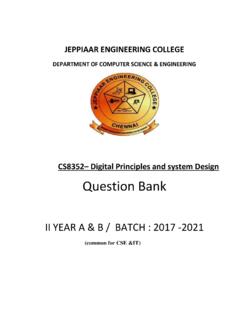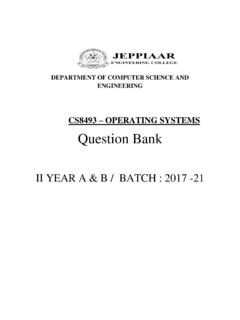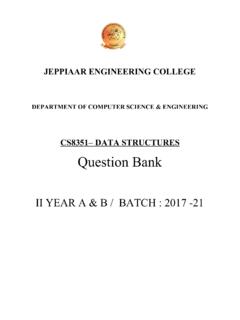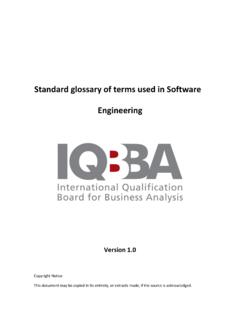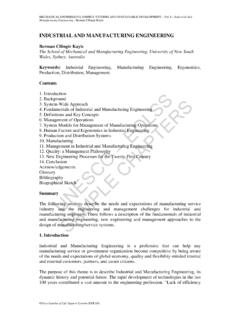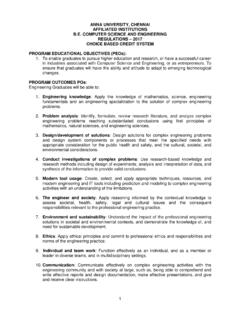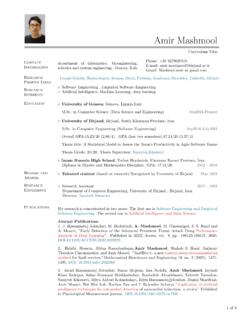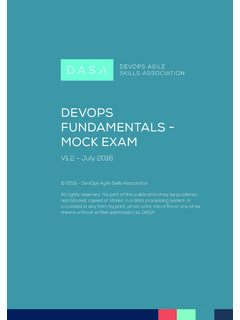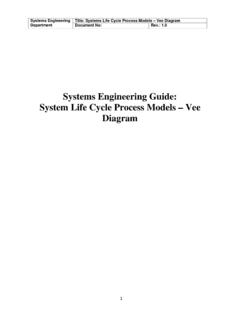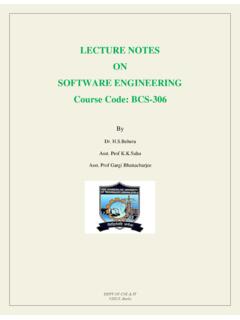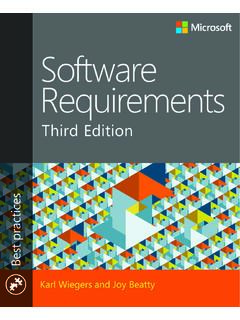Transcription of MG6088 SOFTWARE PROJECT MANAGEMENT ... - …
1 1 DEPARTMENT OF COMPUTER SCIENCE & engineering MG6088 SOFTWARE PROJECT MANAGEMENT Question Bank IV YEAR A & B / BATCH : 2015 -19 2 Vision of Institution To build Jeppiaar engineering College as an Institution of Academic Excellence in Technical education and MANAGEMENT education and to become a World Class University. Mission of Institution M1 To excel in teaching and learning, research and innovation by promoting the principles of scientific analysis and creative thinking M2 To participate in the production, development and dissemination of knowledge and interact with national and international communities M3 To equip students with values, ethics and life skills needed to enrich their lives and enable them to meaningfully contribute to the progress of society M4 To prepare students for higher studies and lifelong learning.
2 Enrich them with the practical and entrepreneurial skills necessary to excel as future professionals and contribute to Nation s economy Program Outcomes (POs) PO1 engineering knowledge: Apply the knowledge of mathematics, science, engineering fundamentals , and an engineering specialization to the solution of complex engineering problems. PO2 Problem analysis: Identify, formulate, review research literature, and analyze complex engineering problems reaching substantiated conclusions using first principles of mathematics, natural sciences, and engineering sciences. PO3 Design/development of solutions: Design solutions for complex engineering problems and design system components or processes that meet the specified needs with appropriate consideration for the public health and safety, and the cultural, societal, and environmental considerations PO4 Conduct investigations of complex problems: Use research-based knowledge and research methods including design of experiments, analysis and interpretation of data, and synthesis of the information to provide valid conclusions.
3 PO5 Modern tool usage: Create, select, and apply appropriate techniques, resources, and modern engineering and IT tools including prediction and modeling to complex engineering activities with an understanding of the limitations. PO6 The engineer and society: Apply reasoning informed by the contextual knowledge to assess societal, health, safety, legal and cultural issues and the consequent responsibilities relevant to the professional engineering practice. 3 PO7 Environment and sustainability: Understand the impact of the professional engineering solutions in societal and environmental contexts, and demonstrate the knowledge of, and need for sustainable development. PO8 Ethics: Apply ethical principles and commit to professional ethics and responsibilities and norms of the engineering practice.
4 PO9 Individual and team work: Function effectively as an individual, and as a member or leader in diverse teams, and in multidisciplinary settings. PO10 Communication: Communicate effectively on complex engineering activities with the engineering community and with society at large, such as, being able to comprehend and write effective reports and design documentation, make effective presentations, and give and receive clear instructions. PO11 PROJECT MANAGEMENT and finance: Demonstrate knowledge and understanding of the engineering and MANAGEMENT principles and apply these to one s own work, as a member and leader in a team, to manage projects and in multidisciplinary environments.
5 PO12 Life-long learning: Recognize the need for, and have the preparation and ability to engage in independent and life-long learning in the broadest context of technological change. Vision of Department To emerge as a globally prominent department, developing ethical computer professionals, innovators and entrepreneurs with academic excellence through quality education and research. Mission of Department M1 To create computer professionals with an ability to identify and formulate the engineering problems and also to provide innovative solutions through effective teaching learning process. M2 To strengthen the core-competence in computer science and engineering and to create an ability to interact effectively with industries.
6 M3 To produce engineers with good professional skills, ethical values and life skills for the betterment of the society. M4 To encourage students towards continuous and higher level learning on technological advancements and provide a platform for employment and self-employment. 4 Program Educational Objectives (PEOs) PEO1 To address the real time complex engineering problems using innovative approach with strong core computing skills. PEO2 To apply core-analytical knowledge and appropriate techniques and provide solutions to real time challenges of national and global society PEO3 Apply ethical knowledge for professional excellence and leadership for the betterment of the society.
7 PEO4 Develop life-long learning skills needed for better employment and entrepreneurship Program Specific Outcomes (PSOs) Students will be able to PSO1 An ability to understand the core concepts of computer science and engineering and to enrich problem solving skills to analyze, design and implement SOFTWARE and hardware based systems of varying complexity. PSO2 To interpret real-time problems with analytical skills and to arrive at cost effective and optimal solution using advanced tools and techniques. PSO3 An understanding of social awareness and professional ethics with practical proficiency in the broad area of programming concepts by lifelong learning to inculcate employment and entrepreneurship skills.
8 BLOOM TAXANOMY LEVELS(BTL) BTL1: Remembering BTL2: Understanding BTL3: Applying BTL4: Analyzing BTL5: Evaluating BTL6: Creating 5 SYLLABUS UNIT I PROJECT EVALUATION AND PROJECT PLANNING 9 Importance of SOFTWARE PROJECT MANAGEMENT Activities Methodologies Categorization of SOFTWARE Projects Setting objectives MANAGEMENT Principles MANAGEMENT Control PROJECT portfolio MANAGEMENT Cost-benefit evaluation technology Risk evaluation Strategic program MANAGEMENT Stepwise PROJECT Planning. UNIT II PROJECT LIFE CYCLE AND EFFORT ESTIMATION 9 SOFTWARE process and Process Models Choice of Process models - mental delivery Rapid Application development agile methods Extreme Programming SCRUM Managing interactive processes Basics of SOFTWARE estimation Effort and Cost estimation techniques COSMIC Full function points - COCOMO II A Parametric Productivity Model - Staffing Pattern.
9 UNIT III ACTIVITY PLANNING AND RISK MANAGEMENT 9 Objectives of Activity planning PROJECT schedules Activities Sequencing and scheduling Network Planning models Forward Pass & Backward Pass techniques Critical path (CRM) method Risk identification Assessment Monitoring PERT technique Monte Carlo simulation Resource Allocation Creation of critical patterns Cost schedules. UNIT IV PROJECT MANAGEMENT AND CONTROL 9 Framework for MANAGEMENT and control Collection of data PROJECT termination Visualizing progress Cost monitoring Earned Value Analysis- PROJECT tracking Change control- SOFTWARE Configuration MANAGEMENT Managing contracts Contract MANAGEMENT .
10 UNIT V STAFFING IN SOFTWARE PROJECTS 9 Managing people Organizational behavior Best methods of staff selection Motivation The Oldham-Hackman job characteristic model Ethical and Programmed concerns Working in teams Decision making Team structures Virtual teams Communications genres Communication plans. 6 TEXT BOOK: 1. Bob Hughes, Mike Cotterell and Rajib Mall: SOFTWARE PROJECT MANAGEMENT Fifth Edition, Tata McGraw Hill, New Delhi, 2012. REFERENCES: 1. Robert K. Wysocki Effective SOFTWARE PROJECT MANAGEMENT Wiley Publication,2011. 2. Walker Royce: SOFTWARE PROJECT MANAGEMENT - Addison-Wesley, 1998. 3. Gopalaswamy Ramesh, Managing Global SOFTWARE Projects McGraw Hill Education (India), Fourteenth Reprint 2013.

